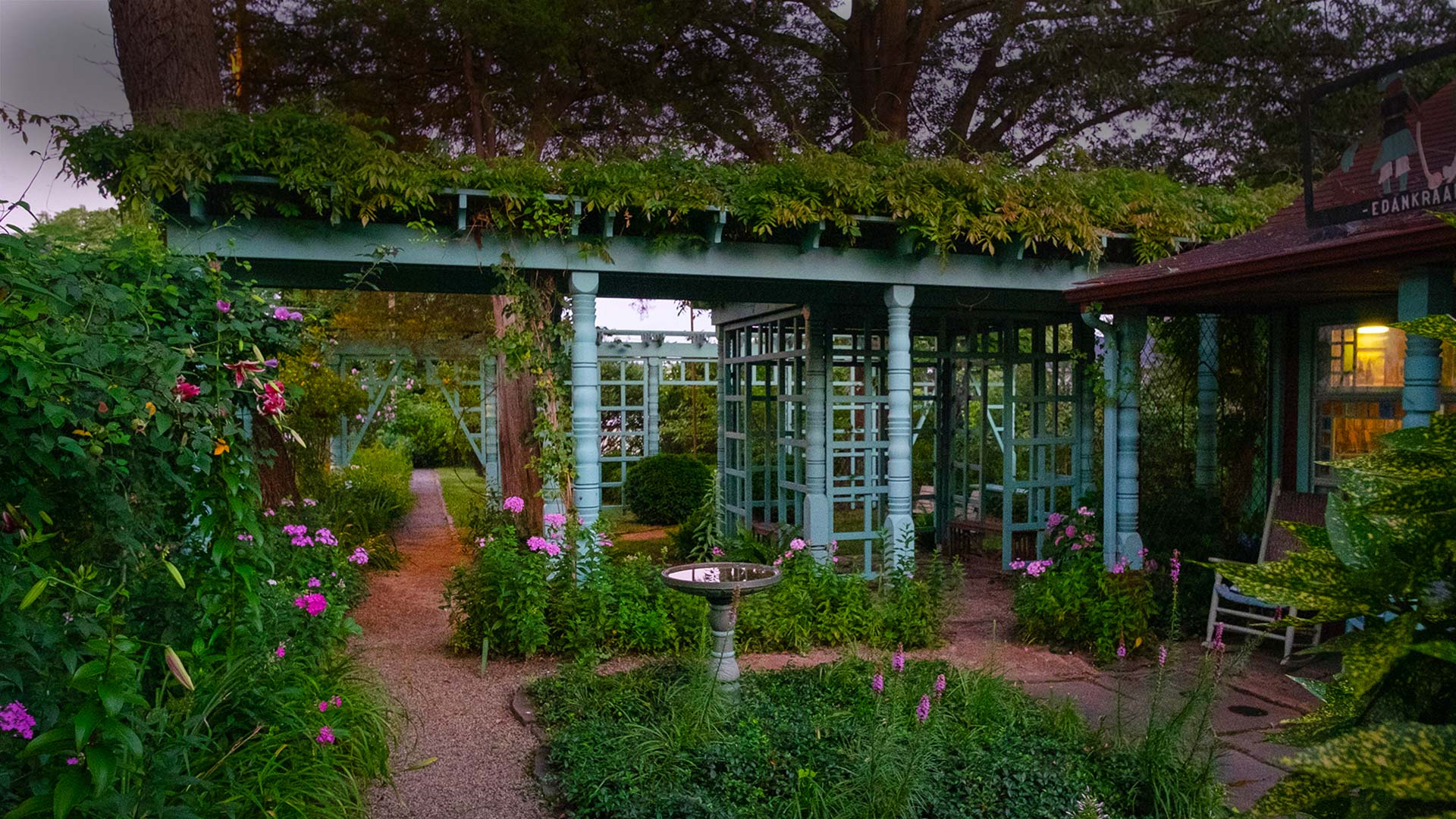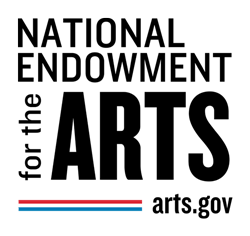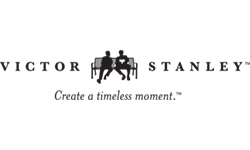The garden at the Anne Spencer House in Lynchburg, Virginia was created and refined over the span of six decades, and was the gathering place for the Harlem Renaissance poet’s friends and colleagues in the 1930s. The 45-foot by 125-foot rectangular-shaped garden included four garden rooms and a single-room writing cottage. In the early 1980s the Lynchburg Hillside Garden Club undertook a rehabilitation of the garden, after which it was opened to the public. However, additional rehabilitation work is required and there is a need for dedicated funding for maintenance and programming to ensure the future of this nationally significant site.
History
The home and garden of Harlem Renaissance poet Anne Spencer (1882-1975) and her husband Edward (1875-1964) is located within the Pierce Street Renaissance Historic District, a two-block stretch in an area that was first settled in the 1850s. During the Civil War, Pierce Street was a Confederate encampment with a military hospital. According to the Lynchburg Regional and Convention Visitors Bureau: “During Reconstruction, the abandoned barracks were converted to housing for Federal soldiers, a freedmen’s school, and a black Methodist church. By the 1880s Pierce Street included one of the first African American–owned grocery stores and a community center and was rapidly becoming a center of activity in the community.”
Anne Spencer was born on a plantation in Henry County, Virginia. Her father Joel Cephus Bannister, formerly enslaved, was of African American, white and Seminole ancestry. Her mother, Sarah Louise Scales, from adjacent Patrick County, was the daughter of a formerly enslaved woman and a member of one of the area's prominent planter families. In 1893, Anne enrolled at Virginia Theological Seminary and Normal School; she entered barely literate and graduated as valedictorian. It was also where she met fellow classmate Edward Spencer.
Edward Spencer grew up at 1321 Pierce Street, and in 1903 Edward and Anne built their Queen Anne-style home on 1313 Pierce Street, shortly after their marriage in 1901. Four of Edward’s brothers also built homes on Pierce Street.
“Edward Spencer was the first African American parcel postman in Lynchburg from 1912 to 1924,” according to the Anne Spencer Home and Garden website. “He was also a talented businessman who ran an organic chicken business, and was a notary, real estate developer, chauffeur, and a creative collector of cast-off building materials.” Anne Spencer taught at her alma mater from 1910 to 1912. In 1924 she was hired to work at the Dunbar High School library, a position she held for twenty years. Dunbar was Lynchburg’s African American high school and the library was the only branch open to the city’s Black population. The Spencers raised their three children in Lynchburg, where Anne also helped found the local chapter of the National Association for the Advancement of Colored People (NAACP).
Despite living in Virginia, Anne Spencer was part of the Harlem Renaissance artistic and literary movement that included W.E.B. Du Bois, Langston Hughes, Paul Robeson, Countee Cullen, Marian Anderson, Zora Neale Houston, George Washington Carver, and Mary McLeod Bethune. Spencer’s first poem was published in The Crisis, the journal of the NAACP, in 1920; Du Bois was her editor. She was prolific, though fewer than 30 of her poems were published during her lifetime. Two years before her death, her work appeared in the influential Norton Anthology of Modern Poetry, a first for an African American woman.
The Spencers’ home and garden became a salon for Anne’s artistic and literary friends, many of whom would also stay at the house as the area’s hotels would not accomodate people of color. The Spencers also hosted students from area schools, local Jack & Jill club meetings, and their eleven grandchildren.
The narrow 45- by 125-foot rectangular garden is located at the back of the house and extends through the block to the street behind. It evolved over time. Photographs from the 1910s show rows of vegetables, a fruit tree, and grape arbor. The 1920s saw the addition of flowers and decorative iron fencing, a gift from Randolph-Macon Woman’s College, which was on Edward’s postal route).
By the 1930s, the garden was divided into four “rooms” beginning with the Rose Garden. A latticed gate, painted in one of Anne’s favorite colors, robin’s egg blue, marks the entry into the Cottage Garden. Edward built a cottage there that was known as “Edankraal,” a combination of the names Edward, Anne, and kraal, the Afrikaans word for dwelling or enclosure. The one-room structure included slabs of greenstone given to Edward by friends at a local quarry, which were used to make the chimney, floor, and terrace. With its heavy sea-foam green turned columns and salvaged stained glass, “Edankraal” provided space for solitude and work, as well as a place to host visitors.
The Arbor Garden featured a wisteria pergola and grape arbor. A path cut diagonally across part of this room and led to the Pool Garden, the largest of the four rooms. A central pathway lined with privet hedges terminates in a circular spray pool flanked by columnar Virginia red cedars that lend verticality to the composition. There was also a semicircular bench by the pool.
 Anne Spencer House and Garden Museum, Lynchburg, VA; photo courtesy Library of Congress, ca1930’s.
Anne Spencer House and Garden Museum, Lynchburg, VA; photo courtesy Library of Congress, ca1930’s.
Edward constructed birdhouse apartments on 30-foot-tall poles and visitors provided gifts of plant materials; Du Bois gave them a sculpture of the head of an Ebo prince that was mounted on the edge of the pool. The Spencers did much of the maintenance work themselves for decades, though they occasionally hired gardeners.
A year after Anne’s death in 1975, the house was listed in the National Register of Historic Places. The National Register nomination concluded: “Few of the nation's literary shrines so effectively invoke the presence of their former occupant.”
The garden, however, became overgrown and in 1983 the Hillside Garden Club, with the blessing of the nonprofit Anne Spencer Foundation, began a multi-year effort to rehabilitate the garden. It was the first time in the history of the Garden Club of Virginia, of which Hillside is a member, that such work had been undertaken for the garden of an African American.
Landscape designer Jane Baber White led the effort, which involved scores of volunteers. The Spencers’ son Chauncey, who lived across the street, provided photographs that aided in the decision to rehabilitate the garden to its 1930s and 1940s appearance. The garden opened to the public in 1985 and was the first home and garden of an African American to be part of Historic Garden Week in Virginia.
In 2020, the United States Postal Service featured Anne Spencer one of four Forever stamps honoring figures of the Harlem Renaissance.

Threat
The Anne Spencer House & Garden Museum is committed to keeping the garden open to the public, just as Anne, Edward, and their children and grandchildren kept an open door for visitors during their long lifetimes and stewardship of the house. However, neglect, and lack of volunteer hours and funding are constant threats.
Upcoming projects include a new focus on outdoor programming that will necessitate turning a chicken house into a set of public restrooms to better serve the public. The Hillside Garden Club would like to re-lay the greenstone terrace in front of the cottage to protect against water damage, and install outdoor lighting for evening functions.
The relationship between the Hillside Garden Club and the Museum has been invaluable over the past several decades, yet the project needs continued support to help keep the garden open and to provide tours and programming focused on the garden and its role in Anne Spencer’s life’s work as a poet and activist.
What You Can Do to Help
Donate to the Anne Spencer House & Garden Museum. The Museum works to preserve the legacy of Anne Spencer and her garden and uses funds for maintenance and programming.
Visit the Museum. Every year, visitors help spread the word about Spencer and her garden. This is an important element in keeping attention on the stewardship of the garden. The garden is open and free every day, dawn to dusk.
Volunteer in the Garden with the Hillside Garden Club. If you are local to Lynchburg and interested in helping in the garden, the Hillside Garden Club has work days once a month. Once each year the club’s monthly meeting is a work day at the garden, which might include shoring up a wall or repainting the trellis.













